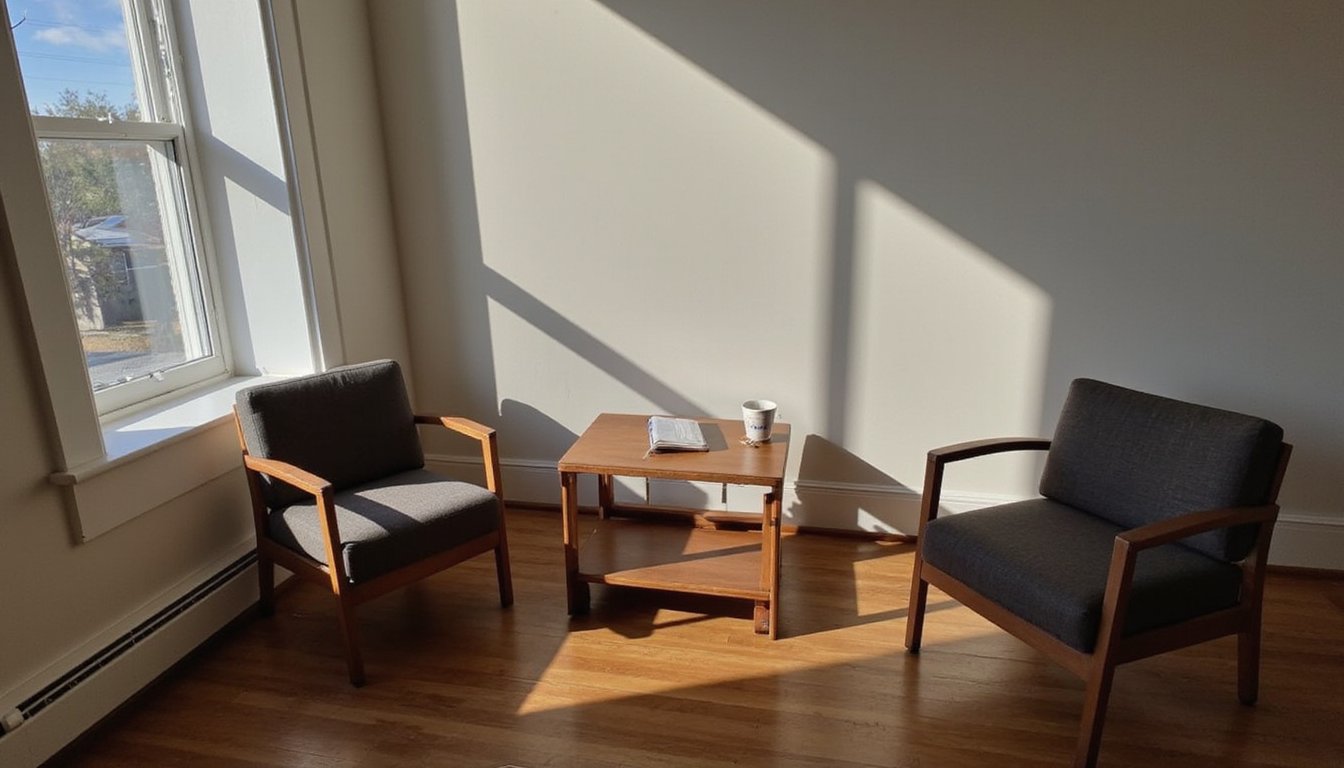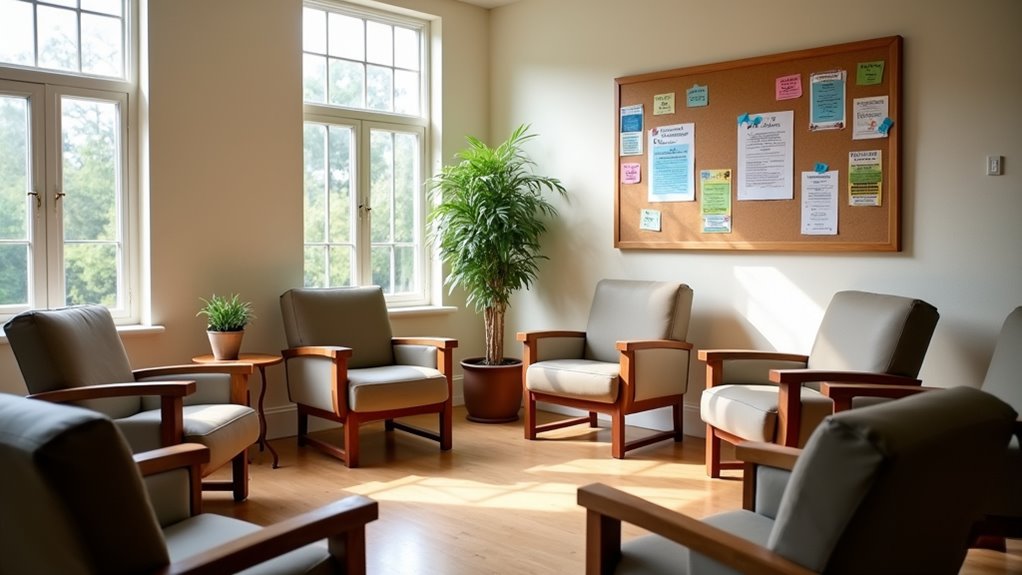Your sustained sobriety after treatment depends on five interconnected support services that work together as pillars of recovery: outpatient programs, individual therapy, group support systems, structured living environments, and all-encompassing relapse prevention planning. Research shows these services provide the highest success rates when used in combination, with 50-70% of participants maintaining abstinence. Each component addresses different recovery needs while reinforcing the others, creating a sturdy foundation for your long-term sobriety expedition.
The Critical Role of Outpatient Programs in Recovery

While inpatient treatment often receives substantial attention, outpatient programs play an equally vital role in addiction recovery, showing comparable success rates and distinct advantages for many individuals. Research shows that 50-70% of participants maintain abstinence after completing outpatient treatment, with success rates matching those of inpatient care. Individual and group therapy remains a core component of effective outpatient programs, helping participants develop essential coping strategies. You’ll find that outpatient programs, including medication assisted treatment, offer necessary flexibility while maintaining effectiveness. These programs allow you to continue your daily responsibilities while receiving treatment, and they’re particularly successful for alcohol and marijuana recovery. Standard outpatient treatment is available at 76% of facilities, making it the most accessible form of care. What’s especially notable is that longer engagement in outpatient care, 12 months or more, considerably reduces your risk of relapse. With proper relapse prevention support and continuous care, you can join the 85-95% of program completers who remain drug-free nine months after discharge. However, patients struggling with opioid use disorder may require more intensive care, as studies show residential treatment programs are significantly more effective for this population.
Building a Strong Foundation Through Individual Therapy
Because individual therapy serves as a cornerstone of addiction recovery, you’ll find it offers unique advantages for building and maintaining sobriety. Through customizable treatment approaches, you’ll receive one-on-one attention that addresses your specific challenges and co-occurring mental health conditions. Incorporating cognitive behavioral therapy can help you identify and modify thoughts and behaviors that contribute to substance use. The success of individual counseling is evident, as formal treatment helps approximately half of all patients complete their programs successfully.
Research demonstrates individual therapy’s effectiveness, with significant improvements in both abstinence rates and psychological well-being. The amplified therapeutic alliance you’ll develop with your counselor becomes a powerful predictor of successful outcomes. For enhanced security, many therapists now use protected platforms to deliver virtual counseling sessions. You’ll benefit from complete privacy while exploring sensitive issues and developing personalized relapse prevention strategies.
While individual therapy may cost more than group sessions, its flexibility allows you to work at your own pace and schedule sessions that accommodate your life circumstances, making it a valuable investment in your recovery path.
Harnessing the Power of Group Support Systems

Group support systems complement individual therapy by providing powerful social dynamics that reinforce recovery goals. Through mutual accountability and cultivating shared identity, you’ll connect with others who understand your path and can offer authentic encouragement during difficult times. Members benefit from the helper therapy principle when sharing personal experiences and supporting others on their journey. The cost-effective nature of group support makes ongoing recovery assistance accessible to more people. Greater social support consistently predicts lower rates of substance use after completing treatment programs.
Group therapy creates a community of understanding, where shared experiences and mutual support become powerful catalysts for lasting recovery.
- Experience 35% lower relapse risk through programs like AA compared to other treatment methods
- Develop imperative coping skills through peer learning and role-playing exercises
- Build lasting relationships with abstinent peers who positively influence your recovery
- Reduce depression and anxiety while strengthening your emotional resilience
Research confirms that participating in support groups notably improves your chances of maintaining sobriety. These environments offer safe spaces to practice communication skills, share experiences, and learn from others who’ve successfully navigated similar challenges. You’ll gain valuable strategies for managing triggers while expanding your network of recovery-focused relationships.
Structured Living Environments and Their Impact
Three key elements define successful structured living environments: daily routines, peer accountability, and professional oversight. When you’re in recovery, these elements create a foundation that substantially improves your chances of maintaining sobriety. Research shows that structured homes with live-in managers and fewer than 10 residents achieve the best outcomes. These environments typically have live-in managers present to provide consistent supervision and support.
Studies indicate that individuals who utilize structured sober living during treatment have a greater likelihood of completing their outpatient programs successfully. You’ll find that community engagement becomes natural in these settings, as you participate in required activities like recovery meetings and shared meals. Through behavioral modeling from peers and staff, you’ll develop essential life skills and healthy habits. Scientific evidence demonstrates that residents who engage in therapeutic activities experience improved mental health outcomes and reduced relapse rates. The statistics are compelling: structured sober living environments lead to 40-45% abstinence rates at 18 months, compared to 25% for self-managed recovery. They’ll also support your progress in outpatient treatment and improve your employment prospects.
Essential Components of Relapse Prevention Planning

A detailed relapse prevention plan combines five critical elements that work together to safeguard your recovery path. You’ll need to systematically identify your personal triggers while building coping skills to manage them effectively. By strengthening support systems through formal and informal networks, you’re creating a safety net that catches early warning signs and provides immediate assistance when needed. Working closely with your therapist and sponsor ensures your plan stays aligned with your recovery goals. The early stages of your journey require extra vigilance since early recovery presents the highest risk of relapse. Understanding that relapse occurs in three distinct stages helps you recognize warning signs before physical use begins.
Building a strong relapse prevention strategy requires identifying triggers, developing coping skills, and creating support networks that catch warning signs early.
- Create written lists of your triggers and rank their intensity levels
- Develop personalized action steps for managing cravings and stress
- Establish connections with accountability partners and support groups
- Build structured routines that include healthy alternatives to substance use
Your prevention plan should adapt as your recovery progresses. Remember to regularly review and adjust your strategies, especially when facing high-risk situations. By maintaining open communication with your support network, you’ll be better equipped to navigate challenges and maintain long-term sobriety.
Integrating Wellness Practices Into Daily Recovery
While maintaining sobriety requires dedication to your recovery plan, integrating wellness practices into your daily routine can markedly augment your trek and diminish relapse risks. Start by incorporating physical activities like walking outdoors or yoga, which reduce stress and strengthen your mind-body connection. Focus on holistic self-care through proper nutrition, hydration, and quality sleep to repair your body and stabilize mood.
Engage in mindfulness practices and stress management techniques to build emotional resilience. You’ll benefit from pursuing cognitive wellness through learning new skills or hobbies. Participate in community-based activities that foster social connections and accountability. Recollect that environmental wellness matters too; accessing healthcare resources and maintaining stable housing directly impact your recovery success. These integrated practices create a sturdy foundation for sustained sobriety.
Creating a Sustainable Support Network
Building a sturdy support network stands as a cornerstone of lasting recovery, complementing your wellness practices with meaningful social connections. Through community engagement and recovery supportive relationships, you’ll find essential resources to maintain your sobriety and thrive in your new lifestyle.
- Connect with sober peers through mutual help organizations like AA or NA, where shared experiences strengthen your resolve
- Integrate professional support, including therapists and healthcare providers, to address both emotional and physical aspects of recovery
- Maintain open communication with supportive family members while establishing boundaries with those who may compromise your sobriety
- Participate actively in sober social events and recreational activities that align with your recovery goals
Your network should encompass diverse sources of support, from professional guidance to peer relationships, creating an extensive system that reinforces your commitment to sustained recovery.
Developing Life Skills for Long-Term Success
Life skills serve as essential building blocks for maintaining long-term sobriety and creating a fulfilling life in recovery. You’ll need to develop practical abilities in key areas, including financial independence, time management, and daily organization. These foundational skills help you maintain stability while reducing stress-related triggers.
Learning emotional regulation techniques and effective communication strategies strengthens your ability to handle challenges and engage meaningfully with your community. You’ll benefit from mastering stress management, problem-solving, and conflict resolution skills to navigate relationships and workplace dynamics. Furthermore, setting clear goals and creating action plans helps you track progress and adjust strategies when needed.
Maintaining Mental Health Through Professional Care
Professional mental health care forms the backbone of sustained recovery after addiction treatment. Your success in maintaining sobriety depends heavily on addressing psychiatric co-morbidity management through ongoing therapy, medication adjustments, and crisis support. You’ll need a comprehensive care plan that integrates individual counseling, psychiatric services, and group support to safeguard your mental well-being.
- Regular sessions with licensed therapists help you develop coping strategies and process underlying trauma
- Psychiatric evaluations guarantee proper medication management and treatment of co-occurring conditions
- Group therapy provides peer support and shared accountability while reducing isolation
- Access to 24/7 crisis intervention prevents mental health emergencies from derailing your recovery
Evidence shows that maintaining engagement with mental health professionals drastically improves your chances of long-term sobriety, with success rates reaching up to 96% in monitored healthcare populations.
Frequently Asked Questions
How Long Should Someone Typically Stay in a Sober Living Home?
You should plan to stay in a sober living home for at least six months, as research shows this residential program duration considerably improves your recovery outcomes. While individual needs vary, studies indicate that longer aftercare program duration (6-8 months) leads to higher abstinence rates and fewer psychiatric symptoms. You’ll experience better stability after the initial 6 weeks, when dropout risks decrease to 25%. Consider your personal progress and readiness for independent living when determining your length of stay.
What Percentage of People Maintain Sobriety After Completing Outpatient Treatment Programs?
You can expect to see 50-70% of people maintaining sobriety after completing outpatient programs, with success rates rising noticeably based on treatment duration. You’ll have the best chances of maintaining sobriety if you stay in treatment for 9+ months, which shows a 71.7% success rate. To optimize your outcomes, you’ll want to combine relapse prevention strategies with regular participation in community-based support groups and formal aftercare services.
Can Family Members Attend Therapy Sessions During the Recovery Process?
Yes, you can include family members in your therapy sessions during recovery. Family involvement is an essential component that considerably enhances treatment outcomes. You’ll find that counseling dynamics can accommodate different formats, including full family sessions, individual meetings, or partial participation based on your family’s needs and comfort level. If your relatives aren’t ready to participate immediately, they can join when they feel prepared. Home-based therapy options are also available for greater accessibility.
Are There Financial Assistance Options Available for Ongoing Recovery Support Services?
Yes, you’ll find several financial assistance options for ongoing recovery support. Medicaid covers many recovery services, including case management and peer support programs. Government funded programs like SAMHSA block grants provide substantial support, while state level initiatives offer housing assistance, employment services, and funding for community centers. You can access these resources through recovery community organizations, treatment centers, and behavioral health clinics in your area.
How Often Should Drug Testing Occur During Post-Treatment Recovery Programs?
You’ll typically need testing 1-3 times per week during your initial 90 days post-treatment, when you’re most vulnerable to relapse. As your recovery stabilizes, testing frequency will decrease to monthly drug screenings. Your program may implement random drug tests to maintain accountability. If you’re in an intensive outpatient program, expect testing every 3-7 days initially. Research shows you’re more likely to maintain sobriety when testing occurs at least twice monthly during early recovery.






